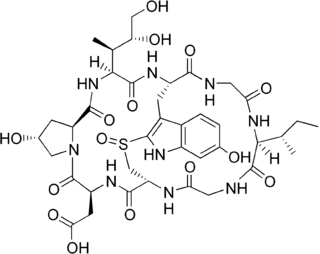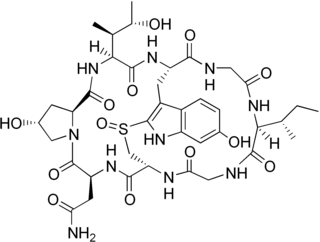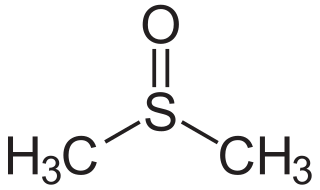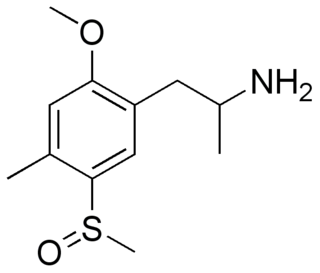 W
WMethyl phenyl sulfoxide is the organosulfur compound with the formula CH3S(O)C6H5. A low-melting white solid, it is an oxidized derivative of thioanisole. The compound is a prototypical chiral sulfoxide. As such it has been prepared by asymmetric oxidation.
 W
WA sulfoxide is a chemical compound containing a sulfinyl (SO) functional group attached to two carbon atoms. It is a polar functional group. Sulfoxides are the oxidized derivatives of sulfides. Examples of important sulfoxides are alliin, a precursor to the compound that gives freshly crushed garlic its aroma, and dimethyl sulfoxide (DMSO), a common solvent.
 W
WAdrafinil is a eugeroic that was formerly used in France to promote alertness, attention, wakefulness, positive mood, and other parameters, particularly in the elderly. It was also used off-label by individuals who wished to avoid fatigue, such as night workers or others who needed to stay awake and alert for long periods of time. Additionally, "adrafinil is known to a larger nonscientific audience, where it is considered to be a nootropic agent."
 W
WAlliin is a sulfoxide that is a natural constituent of fresh garlic. It is a derivative of the amino acid cysteine. When fresh garlic is chopped or crushed, the enzyme alliinase converts alliin into allicin, which is responsible for the aroma of fresh garlic.
 W
Walpha-Amanitin or α-amanitin is a cyclic peptide of eight amino acids. It is possibly the most deadly of all the amatoxins, toxins found in several species of the mushroom genus Amanita, one being the death cap as well as the destroying angel, a complex of similar species, principally A. virosa and A. bisporigera. It is also found in the mushrooms Galerina marginata and Conocybe filaris. The oral LD50 of amanitin is 0.11 mg/kg for rats.
 W
Wbeta-Amanitin or β-amanitin is a cyclic peptide comprising eight amino acids. It is part of a group of toxins called amatoxins, which can be found in several mushrooms belonging to the genus Amanita. Some examples are the death cap and members of the destroying angel complex, which includes A. virosa and A. bisporigera. Due to the presence of α-amanitin, β-amanitin, γ-amanitin and ε-amanitin these mushrooms are highly lethal to human beings.
 W
Wgamma-Amanitin or γ-amanitin is a cyclic peptide of eight amino acids. It is an amatoxin, a group of toxins isolated from and found in several members of the mushroom genus Amanita, one being the death cap as well as the destroying angel, a complex of similar species, principally A. virosa and A. bisporigera. The compound is highly toxic, inhibits RNA polymerase II, disrupts synthesis of mRNA, and can be fatal.
 W
WArmodafinil is the enantiopure compound of the eugeroic modafinil (Provigil). It consists of only the (R)-(−)-enantiomer of the racemic modafinil. Armodafinil is produced by the pharmaceutical company Cephalon Inc. and was approved by the U.S. Food and Drug Administration (FDA) in June 2007. In 2016, the FDA granted Mylan rights for the first generic version of Cephalon's Nuvigil to be marketed in the U.S.
 W
WAzeloprazole is a drug under investigation for acid-related medical conditions responsive to suppressing the production of stomach acid. It is considered to be a member of the proton pump inhibitor class of medications.
 W
WBiotin sulfoxide is the substance that is formed when biotin is exposed to ultraviolet light in the presence of oxygen.
 W
WCE-123 is an analog of modafinil, the most researched of a series of structurally related heterocyclic derivatives. In animal studies, CE-123 was found to improve performance on tests of learning and memory in a manner consistent with a nootropic effect profile.
 W
WCenicriviroc is an experimental drug candidate for the treatment of HIV infection and in combination with Tropifexor for non-alcoholic steatohepatitis. It is being developed by Takeda and Tobira Therapeutics.
 W
WCRL-40,940 is the bisfluoro analog of modafinil. It is a eugeroic as well as a weak dopamine reuptake inhibitor. Its inventors claim that it is more effective than modafinil and adrafinil, with fewer side effects. It was patented in 2013, and Phase I clinical trials have been underway since December 2015.
 W
WCRL-40,941 is a eugeroic closely related to adrafinil and modafinil. It is the bis(p-fluoro) ring-substituted derivative of adrafinil. CRL-40,941 was found to produce antiaggressive effects in animals, which adrafinil does not produce.
 W
WDexlansoprazole, sold under the trade name Dexilant among others, is a medication which reduces stomach acid. It is used to treat gastroesophageal reflux disease. Effectiveness is similar to other proton pump inhibitors (PPIs). It is taken by mouth.
 W
WDibromodiethyl sulfoxide is a sulfoxide (S=O) containing two 2-bromo-ethyl substituents.
 W
WDiethyl sulfoxide, C4H10OS, is a sulfur-containing organic compound.
 W
WDimethyl sulfoxide (DMSO) is an organosulfur compound with the formula (CH3)2SO. This colorless liquid is an important polar aprotic solvent that dissolves both polar and nonpolar compounds and is miscible in a wide range of organic solvents as well as water. It has a relatively high boiling point. DMSO has the unusual property that many individuals perceive a garlic-like taste in the mouth after contact with the skin.
 W
WEsomeprazole, sold under the brand name Nexium among others, is a medication which reduces stomach acid. It is used to treat gastroesophageal reflux disease, peptic ulcer disease, and Zollinger–Ellison syndrome. Effectiveness is similar to other proton pump inhibitors (PPIs). It is taken by mouth or injection into a vein.
 W
WFensulfothion is an insecticide and nematicide. It is highly toxic and listed as an extremely hazardous substance. It is widely used on corn, onions, rutabagas, pineapple, bananas, sugar cane, sugar beets, pea nuts, etc.
 W
WFipronil is a broad-spectrum insecticide that belongs to the phenylpyrazole chemical family. Fipronil disrupts the insect central nervous system by blocking GABA-gated chloride channels and glutamate-gated chloride (GluCl) channels. This causes hyperexcitation of contaminated insects' nerves and muscles. Fipronil's specificity towards insects is believed to be due to its greater affinity to the GABAA receptors of insects, than to those of mammals, and to its action on GluCl channels which do not exist in mammals.As of 2017 there did not appear to be significant resistance, at least among fleas, to this insecticide.
 W
WFlosequinan is a quinolone vasodilator that was discovered and developed by Boots UK and was sold for about a year under the trade name Manoplax. It had been approved in 1992 in the US and UK to treat people with heart failure who could not tolerate ACE inhibitors or digitalis.
 W
WGR-159897 is a potent and selective NK2 receptor antagonist drug. It has anxiolytic effects in animal models, and also inhibits bronchoconstriction of the airways, which may potentially make it useful in the treatment of asthma.
 W
WIlaprazole is a proton pump inhibitor (PPI) used in the treatment of dyspepsia, peptic ulcer disease (PUD), gastroesophageal reflux disease (GORD/GERD) and duodenal ulcer. It is available in strengths of 5, 10, and 20 mg.
 W
WLansoprazole, sold under the brand name Prevacid among others, is a medication which reduces stomach acid. It is used to treat peptic ulcer disease, gastroesophageal reflux disease, and Zollinger–Ellison syndrome. Effectiveness is similar to other proton pump inhibitors (PPIs). It is taken by mouth. Onset is over a few hours and effects last up to a couple of days.
 W
WMesoridazine (Serentil) is a piperidine neuroleptic drug belonging to the class of drugs called phenothiazines, used in the treatment of schizophrenia. It is a metabolite of thioridazine. The drug's name is derived from the methylsulfoxy and piperidine functional groups in its chemical structure.
 W
W6-(Methylsulfinyl)hexyl isothiocyanate is a compound within the isothiocyanate group of organosulfur compounds. 6-MITC is obtained from cruciferous vegetables, chiefly wasabi. Like other isothiocyanates, it is produced when the enzyme myrosinase transforms the associated glucosinolate into 6-MITC upon cell injury.
 W
WModafinil, sold under the brand name Provigil among others, is a medication to treat sleepiness due to narcolepsy, shift work sleep disorder, or obstructive sleep apnea. While it has seen off-label use as a purported cognitive enhancer, the research on its effectiveness for this use is not conclusive. It is taken by mouth.
 W
WModafinil acid, also known as modafinilic acid or modafinil carboxylate, is the major metabolite of modafinil, and one of the two major metabolites of modafinil – the other being modafinil sulfone. Modafinil acid is also a metabolite of the modafinil prodrug, adrafinil, and the (R)-(–)-enantiomer is a metabolite of armodafinil, the (R)-(–)-enantiomer of modafinil. Modafinil acid seems to be inactive, and similarly to modafinil sulfone, does not appear to contribute to the wakefulness-promoting/psychostimulant effects of modafinil.
 W
WOmeprazole, sold under the brand names Prilosec and Losec among others, is a medication used in the treatment of gastroesophageal reflux disease (GERD), peptic ulcer disease, and Zollinger–Ellison syndrome. It is also used to prevent upper gastrointestinal bleeding in people who are at high risk. Omeprazole is a proton-pump inhibitor (PPI) and its effectiveness is similar to other PPIs. It can be taken by mouth or by injection into a vein.
 W
WOxfendazole is a broad spectrum benzimidazole anthelmintic. Its main use is for protecting livestock against roundworm, strongyles and pinworms. Oxfendazole is the sulfoxide metabolite of fenbendazole.
 W
WOxydemeton-methyl is an organothiophosphate insecticide. It is primarily used to control aphids, mites, and thrips.
 W
WOxydisulfoton is a chemical compound used as an acaricide and insecticide. It is classified as an extremely hazardous substance in the United States as defined in Section 302 of the U.S. Emergency Planning and Community Right-to-Know Act, and is subject to strict reporting requirements by facilities which produce, store, or use it in significant quantities.
 W
WPantoprazole, sold under the brand name Protonix among others, is a medication used for the treatment of stomach ulcers, short-term treatment of erosive esophagitis due to gastroesophageal reflux disease (GERD), maintenance of healing of erosive esophagitis, and pathological hypersecretory conditions including Zollinger–Ellison syndrome. It may also be used along with other medications to eliminate Helicobacter pylori. Effectiveness is similar to other proton pump inhibitors (PPIs). It is available by mouth and by injection into a vein.
 W
WRabeprazole, sold under the brand name Aciphex, among others, is a medication that decreases stomach acid. It is used to treat peptic ulcer disease, gastroesophageal reflux disease, and excess stomach acid production such as in Zollinger–Ellison syndrome. It may also be used in combination with other medications to treat Helicobacter pylori. Effectiveness is similar to other proton pump inhibitors (PPIs). It is taken by mouth.
 W
WSB 203580 is a specific inhibitor of p38α and p38β which suppresses downstream activation of MAPKAP kinase-2 and heat shock protein 27. At low concentrations, it does not inhibit JNK activity.
 W
WSulforaphane is a compound within the isothiocyanate group of organosulfur compounds. It is obtained from cruciferous vegetables such as broccoli, Brussels sprouts, and cabbages. It is produced when the enzyme myrosinase transforms glucoraphanin, a glucosinolate, into sulforaphane upon damage to the plant, which allows the two compounds to mix and react. Young sprouts of broccoli and cauliflower are particularly rich in glucoraphanin.
 W
WSulindac is a nonsteroidal anti-inflammatory drug (NSAID) of the arylalkanoic acid class that is marketed as Clinoril. Imbaral is another name for this drug. Its name is derived from sul(finyl)+ ind(ene)+ ac(etic acid) It was patented in 1969 and approved for medical use in 1976.
 W
WSulmazole is a cardiotonic drug. Sulmazole has the chemical formula C14H13N3O2S and a molecular weight of 287.34 g/mol.
 W
Wsyn-Propanethial S-oxide (C3H6OS), a member of a class of organosulfur compounds known as thiocarbonyl S-oxides (formerly "sulfines"), is a volatile liquid that acts as a lachrymatory agent (triggers tearing and stinging on contact with the eyes). The chemical is released from onions, Allium cepa, as they are sliced. The release is due to the breaking open of the onion cells and their releasing enzymes called alliinases, which then break down amino acid sulfoxides, generating sulfenic acids. A specific sulfenic acid, 1-propenesulfenic acid, formed when onions are cut, is rapidly rearranged by a second enzyme, called the lachrymatory factor synthase or LFS, giving syn-propanethial S-oxide. The gas diffuses through the air and, on contact with the eye, it stimulates sensory neurons creating a stinging, painful sensation. Tears are released from the tear glands to dilute and flush out the irritant. A structurally related lachrymatory compound, syn-butanethial S-oxide, C4H8OS, has been found in another genus Allium plant, Allium siculum.
 W
WTenatoprazole is a proton pump inhibitor drug candidate that was undergoing clinical testing as a potential treatment for reflux oesophagitis and peptic ulcer as far back as 2003. The compound was invented by Mitsubishi Tanabe Pharma and was licensed to Negma Laboratories.
 W
W7α-Thiomethylspironolactone sulfoxide is a metabolite of spironolactone, an antimineralocorticoid and antiandrogen medication. 7α-TMS sulfoxide is specifically formed from 7α-thiomethylspironolactone (7α-TMS).
 W
WTOMSO (2-methoxy]]-4-methyl-5-methylsulfinylamphetamine) is a lesser-known psychedelic drug and a substituted amphetamine. TOMSO was first synthesized by Alexander Shulgin. In his book PiHKAL, the dosage range is listed as 100–150 mg, and the duration listed as 10–16 hours. TOMSO is inactive on its own; it is activated with the consumption of alcohol. It produces intense time distortion and a threshold. Very little data exists about the pharmacological properties, metabolism, and toxicity of TOMSO.
 W
WThe White catalyst is a transition metal coordination complex named after the chemist by whom it was first synthesized, M. Christina White, a professor at the University of Illinois. The catalyst has been used in a variety of allylic C-H functionalization reactions of α-olefins. In addition, it has been shown to catalyze oxidative Heck reactions.
 W
WY-23684 is an anxiolytic drug with a novel chemical structure, which is used in scientific research. It has similar effects to benzodiazepine drugs, but is structurally distinct and so is classed as a nonbenzodiazepine anxiolytic.